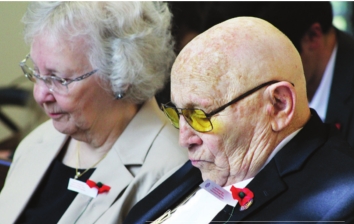A FRENCH HONOR

WWII vet receives Legion of Honor award
Marvin Graham, 93, is willing to share his memories as a ball turret gunner in World War II, answering questions posed to him about experiences nearly 75 years ago when he was 18 years old and making his mark as a member of “The Greatest Generation.”
The Oaks of Louisiana resident, who lives with wife Sarrah at Savannah at The Oaks, is less willing to accept all the praise and words of gratitude that have been heaped on him since he was awarded the Legion of Honor from the French Republic.
He wears humility like he wears his Distinguished Flying Cross, his Air Medal with three Oak Leaf Clusters and the ETO ribbon with four Bronze Stars. That he would receive France’s highest decoration, first established by Napoleon Bonaparte in 1802, is a source of pride – as it should be – and surprise.
“I was taken aback,” Graham says about his being chosen for the prestigious honor. His selection was a sixmonth process and was made, in part, because of his role in three main campaigns of the liberation of France: Normandy, Provence/Southern France and Northern France.
Graham joins Gens. Dwight D. Eisenhower and Douglas MacArthur, among a very small number of American recipients – all of whom risked their lives during World War II defending liberty.
Graham enlisted in the United States Air Force in 1942, patriotism and the desire to fight for a worthwhile cause fueling his decision. His two-year stint included 30 missions, the last mission with a different crew and the most memorable and most harrowing.
He trained as a ball turret gunner, one of the most dangerous assignments in World War II. As a ball turret gunner, he swiveled around in a non-retractable Plexiglass bubble mounted to the belly of a B-24 and, therefore, easily an airman’s coffin if hit by enemy fire. With him were two heavy machine guns, ammunition and sights. His responsibility was to help protect the airplane.
Graham says his plane often drew fire from the enemy in the sky and from the ground. “When the fighters were coming at you, it wasn’t good,” he says, admitting there were times when he was afraid.
He remembers his first mission very well.
It was on Dec. 24, 1943, to a mystery target in France. There would be 28 other successful missions with his original crew members hitting strategic enemy targets. With each successful mission, he and his crew got closer to each other – “we were family” – and to coming home: Kiel, Germany; Frankfurt, Germany; St. Pol, France; Northern France; Brandenburg, Germany; Siracourt, France; Bernburg, Germany; Münster, Germany; Friedrichshafen, Germany; Wizernes, France; St. Trond Air Force Base, Belgium …
Just one more mission to reach 30 and they could go home.
A case of appendicitis delayed Graham’s 30-mission requirement, and he was unable to complete his tour with his original crew.
After three surgeries and a longer-thanexpected recovery, Graham joined another crew for his 30th and final mission. “This mission was fierce with ground fire,” he says. “We had to fly low to hit enemy positions, and we got shot up very badly. It ‘hit the fan.’ They were shooting at us with machine guns, rifles, pistols, everything.”
“It was luck that we made it back,” he says. “The pilot flew the plane back to England without two engines and with more than 300 bullet holes.”
“Those of us who came home are lucky to be alive,” he says.
At age 93 and nearly 75 years later, that realization for Marvin Graham has not faded. Nor has his American pride.
– Terrie M. Roberts
